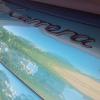I can highly recommend the search features, diagnosis and advise provided by the members of RENNTECH.ORG. I was able to save an estimated A$2000 in fault code diagnosis labour and parts in my first use and as a result freely made a donation to help keep this valuable web site going. In particular I ‘d like to thanks the members: Loren, 1999Porsche911, and carDorque for their experience and knowledge.
I thought it was worth sharing my particular issue as it took me several hours of research and reading renntech forums. I’m in Australia and own a RoW RHD MY2000 996 3.4L tiptronic with just over 100,000km (~62k miles). I recently upgraded from a 1990 928 S4. The S4 was a great car, but the 996 leaves it for dead.
Anyway under hard acceleration both the PSM and ABS fault lights would come on (with no check engine light (CEL)**) everytime. Both faults would reset each time the engine was restarted. No other obvious faults. A local used Porsche dealer thought it was one of the wheel sensors but did not have a fault code reader to confirm. So I took the car to a specialist Independent Porsche Repairer (IPR) would read out the faults. Here’s what they got:
From the DME: P0102 - Mass Air Flow (MAF) Sensor
P1130 - Oxygen Sensing adaptation, idle range, bank 2
From the Tip: P1770 – Load signal from ECM
From the PSM 5525 – Torque transfer from DME disturbed at times
The IPR said they’d need to spend at least 1-2 days in labour diagnosing what all these faults meant and started to warm me to a faulty DME (big $$$). I was hoping the PST2 would have just said I had a faulty wheel sensor to replace, so I drove the car away to consider my options.
I then by pure chance started searching the web and quickly got hits to RennTech. **First thing I discovered was that the CEL does not light with P0102, P1130 errors with RoW cars. Didn’t think this piece of info mattered much but it became vital when reading posts by USA owners. I was able to find literally masses of advise on each fault code using the search functions.
Reading each discussion thread the fix was not looking to good, worst case replace DME, replace ABS. Then on second read I started to see an interrelationship between the fault codes so I prepared a fault tree and a list of potential fixes from cheapest DIY to $$$ in parts and workshop.
It didn’t take long to soon realise that several of the faults appeared to be secondary faults. The checklist from the workshop manual for the Tiptronic P1770 fault said fix DME fault first then check Tip to DME wiring. So P1770 was likely a secondary to DME faults P0102 and P1130.
I then found threads where other 996 owners had experienced exactly the same PSM/ABS faults under WOT. These threads contained the 5525 fault code with advise pointing to the MAF sensor. So PSM code 5525 was likely a secondary to the DME P0102.
I then searched for P1130 and found the potential causes were the MAF, fuel pressure high, fuel injector leaking, EVAP canister purge valve open. Again this was pointing the P0102 as the source.
I discounted any faulty wheel sensors or front shock absorber wiring harness issues in the treads as the PST2 didn’t pull any related codes for these.
So based on the posts I was able to reasonably say that the P0102 fault was the primary issue and I either had an intake air leak, bad sensor, or wiring fault. I then prepared the following lists of checks, in order of cheapest DIY to most expensive, based on all the posts:
1. Check Air filter not dirty
2. Clean MAF sensor
3. Check MAF sensor wiring (open cct, short cct, blown fuse)
4. Replace MAF
If these checks failed to fix the problem, then it was off to the workshop to look at the expensive ones:
a. Checking for a split in the Air Oil Separator (AOS) bellows.
b. Check for faulty DME, ABS CU and replace
I checked the air filter, wiped out the air box and cleaned the MAF sensor, terminals and connector with MAF cleaner, checked the MAF wiring for shorts and while there cleaned the throttle body with carby cleaner. Left the car overnight for the MAF to dry and battery disconnected and followed all the work instructions after disconnecting battery from the workshop manuals (Repair Group 9).
I’ve now done 225km (~140miles) since cleaning the MAF sensor. I am very happy to report that I only spent A$36.00 (US$20) on a can of MAF cleaner and tool to remove/replace the MAF sensor. No more ASB/PSM faults lights !!!! It sure was nice testing that the fix worked – all those horses and torque. I just had to check many times over the 0-100 spec.
I guess the morale is, use the resources you have especially Renntech and the members experience as it will save you time and money, and if nothing more you will be educated if you need to talk to a repairer. It’s also not always obvious what the fault is – a dirty MAF sensor causing a failure in the ABS/PSM certainly wasn’t my first thought.
I hope putting this all together in one email helps someone else like it did for me. Again, I‘d like to thanks the members: Loren, 1999Porsche911, and carDorque for their wisdom. Here are the links the threads I used (there are many, many more, but these got me there):
PSM + ABS Fault lights (PSM CU Fault code 5525)
http://www.renntech.org/forums/index.php?showtopic=10730
http://www.renntech.org/forums/index.php?showtopic=13502
http://www.renntech.org/forums/index.php?showtopic=3497
http://www.renntech.org/forums/index.php?showtopic=13920
http://www.renntech.org/forums/index.php?showtopic=10972
DME Fault P0102 (P0103)
http://www.renntech.org/forums/index.php?showtopic=19222
http://www.renntech.org/forums/index.php?showtopic=16476
DME Fault P1130 (P1128)
http://www.renntech.org/forums/index.php?showtopic=6861
http://www.renntech.org/forums/index.php?showtopic=14596
http://www.renntech.org/forums/index.php?showtopic=23595
http://www.renntech.org/forums/index.php?showtopic=13381
Tiptronic CU Fault 1770
No threads referred on RennTech. Used workshop manual tiptronic diagnosis group 37 DTC 22.
Regards,
Alex



